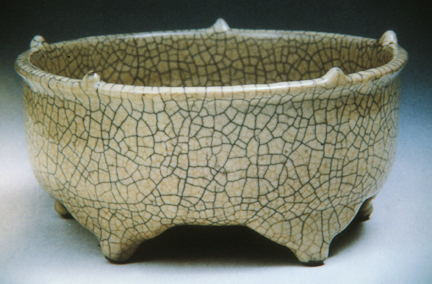
SONG GE WARE FOOTED BOWL, PORCELAIN,
China, 1127-1279 CE
ART 198 - HISTORY OF WORLD CERAMICS
| Another of the five imperial wares from the Song dynasty was GE ware. The only problem with Ge ware is that no one really knows what it looked like, where it was made, or exactly when. It is so similar in look and composition to GUAN ware that no one can really tell it apart. This piece is tentatively identified as Ge ware, but could just as easily be Guan. This unusual 5 footed bowl shows a distinctive pattern of crazing. Note that the crazing has been stained two different colors. This effect is called 'iron wire and golden thread,' an appropriately poetic name. Crazing has been discussed previously, and here is a variation on how it was used by the Song potters to create a surface effect. During the cooling cycle of the kiln, as the piece and its glaze shrink, the network of fine fractures in the glaze known as crazing develops. Most crazing happens during this early stage, but the process will continue for days, weeks, or even years, and this is called delayed crazing, as the glaze continues to adjust to the clay surface. After the initial phase of crazing the potter would paint the piece with a black ink. The ink would enter the fractures in the glaze surface, and then the potter could wipe the piece clean, removing the ink from the surface, but leaving the ink in the fracture lines. Next the piece would be left alone for a period of time, during which delayed crazing would continue. A paler ink, in this case an amber colored one, would then be painted onto the piece again, and the amber ink would penetrate the new fractures as well as the initial ones. Again the piece would then be wiped clean. Now the new fracture lines would show the golden color, while the initial fracture lines would still show black, because the lighter amber color would not be visible there. This is another example of how the Song potter used the natural characteristics of the clay and glaze to create surface interest rather that painting images or patterns. | SONG GE WARE FOOTED BOWL, PORCELAIN, China, 1127-1279 CE |
|
|